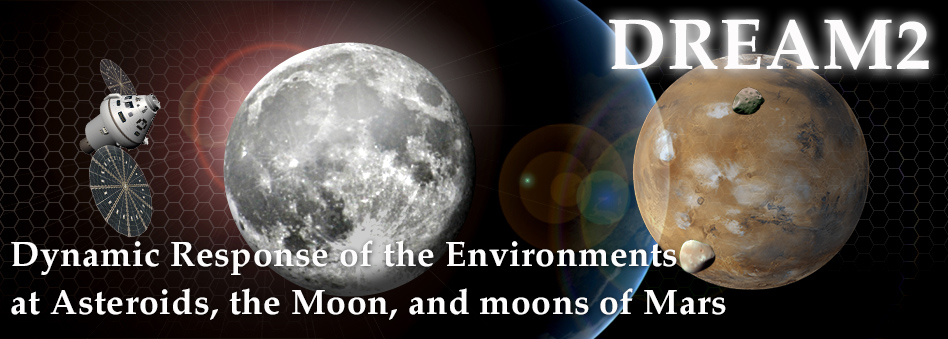
Dynamic Response of the Environments at Asteroids, the Moon, and moons of Mars
Goddard's DREAM2 Center for Space Environments
DREAM2 incorporates over 30 science investigators from over 10 academic Institutions to study the space environment at exploration targets. DREAM2 is:
- A theory, modeling, data analysis research team examining the space environment at airless bodies
- Answering "How does the space environment affect volatiles, exospheres, plasmas, surface micro-structure, and visiting human systems at any exposed rocky body?"
- Emphasizing the dynamic solar storms and human interactions at airless bodies.
- A modeling center that maintains, advances, and integrates state-of-the-art neutral, plasma, radiation, and surface interaction models
- Sponsored by Solar System Exploration Research Institute (SSERVI) Headquartered out of Ames Research Center Moffett Field CA, 94035
DREAM2 NEWS
DREAM2 Scientist sees effect of meteor showers in Mercury's Exosphere Dec 12, 2014

DREAM2's Rosemary Killen and colleague Joe Hahn reports on a periodic surge of calcium atoms in the exosphere of Mercury as tracing back to impacts by meteor streams possibly associated with comet Encke. The press release is found at:
and the accepted science paper in Incarus is at:
http://www.sciencedirect.com/science/article/pii/S0019103514006745
DREAM2 Scientist Hurley: 'Women Count' Nov 17, 2014
DREAM2 scientist Dana Hurley presents a thoughtful essay on the selection and advancement of women in science published in AGU's journal, EOS. See
http://onlinelibrary.wiley.com/doi/10.1002/2014EO440008/abstract?campaign=w
and
http://onlinelibrary.wiley.com/doi/10.1002/2014EO440008/pdf
DREAM2 Featured in Colloquium at Howard University Nov 5, 2014
Bill Farrell (DREAM2 PI) presented an overview of DREAM2.s modeling and research efforts to students and faculty in the Department of Physics and Astronomy at Howard University on October 29. Lora Bleacher (Education Lead) also presented opportunities for students to get involved in DREAM2 research via undergraduate internships and outreach. The abstract and presentation can be found at http://physics1.howard.edu/news/news_seminars14.html.
DREAM2 team prepares for the upcoming LEAG meeting Oct 16, 2014

DREAM2 team members from around the country are presenting at the upcoming Lunar Exploration Analysis Group (LEAG) community meeting held at Applied Physics Laboratory in Laurel MD on 10/22-24. The meeting webpage is found at http://www.hou.usra.edu/meetings/leag2014/.
DREAM2-related Postdoctoral Position in Lunar Research Sept 29, 2014
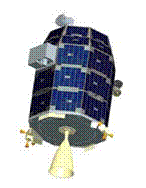
The Department of Physics and Astronomy at the University of Iowa is searching for a postdoctoral research scientist to study the interaction of the Moon's surface, exosphere, and magnetic fields with the space environment. The successful candidate will work in collaboration with Prof. Jasper Halekas, as well as other researchers from the LADEE and ARTEMIS teams and the DREAM2 node of SSERVI. Details and application instructions available at:
http://www.physics.uiowa.edu/~jhalekas/LADEE-DREAM_Postdoc_Ad.txt
DREAM2 Scientists featured in NY Times Article Sept 9, 2014
Andrew Jordan (UNH) and Tim Stubbs (GSFC) work on deep dielectric discharging in lunar polar regions was recently highlighted in the NY Times .Space and Cosmos. report. See:
http://www.nytimes.com/2014/09/09/science/revisiting-the-moon.html?smid=pl-share&_r=0
Electric Sparks May Alter the Evolution of Lunar Soil Aug 21, 2014
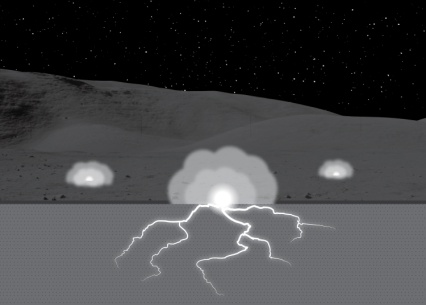
The Moon appears to be a tranquil place, but modeling done by University of New Hampshire (UNH) and NASA scientists suggests that, over the eons, periodic storms of solar energetic particles may have significantly altered the properties of the soil in the moon's coldest craters through the process of sparking.a finding that could change our understanding of the evolution of planetary surfaces in the solar system.
To read more see
http://www.nasa.gov/content/goddard/electric-sparks-may-alter-evolution-of-lunar-soil/
DREAM2 scientists Andrew Jordan and Tim Stubbs just published this work in JGR.
http://onlinelibrary.wiley.com/doi/10.1002/2014JE004648/abstract
DREAM2 Interns present their summer's work Aug 7, 2014
DREAM2 interns gave their end-of-summer presentations at an open seminar on 8/5. These talks were entitled 'Lunar South Pole Space Weather' by Janelle Holmes (Howard University), 'Building SPACE (Science Payloads and Advanced Concepts for Exploration) Interactive Tool' by Robin Leiter (University of Virginia) and 'Apollo Suprathermal Ion Detector Experiment (SIDE) Data Access and Analysis' by Anastasia Newheart (Howard University). The interns did great work and obtained very interesting results.
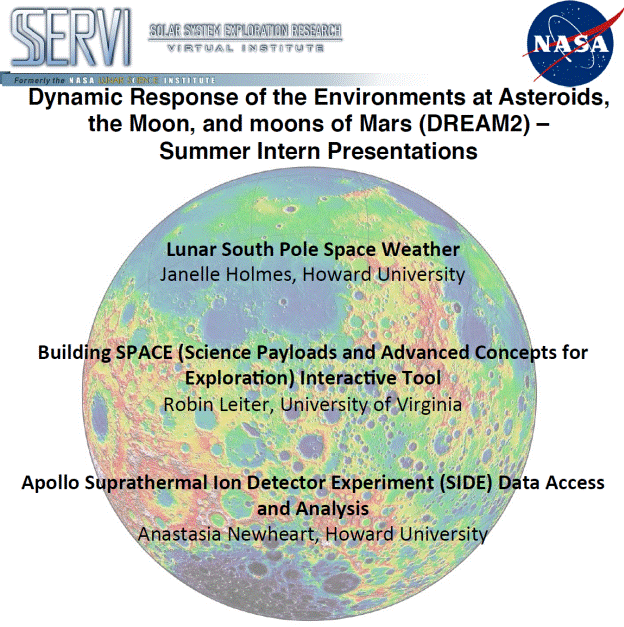
SSERVI's Exploration Science Forum Agenda Available Online July 15,2014

The ESF agenda is now available at:
http://nesf2014.arc.nasa.gov/agenda
Lots of great talks and posters to be presented! All the action is next week (7/21-23) at NASA/Ames.
SIDE Count Rates and Ion Cyclotron Wave Activity July 9,2014
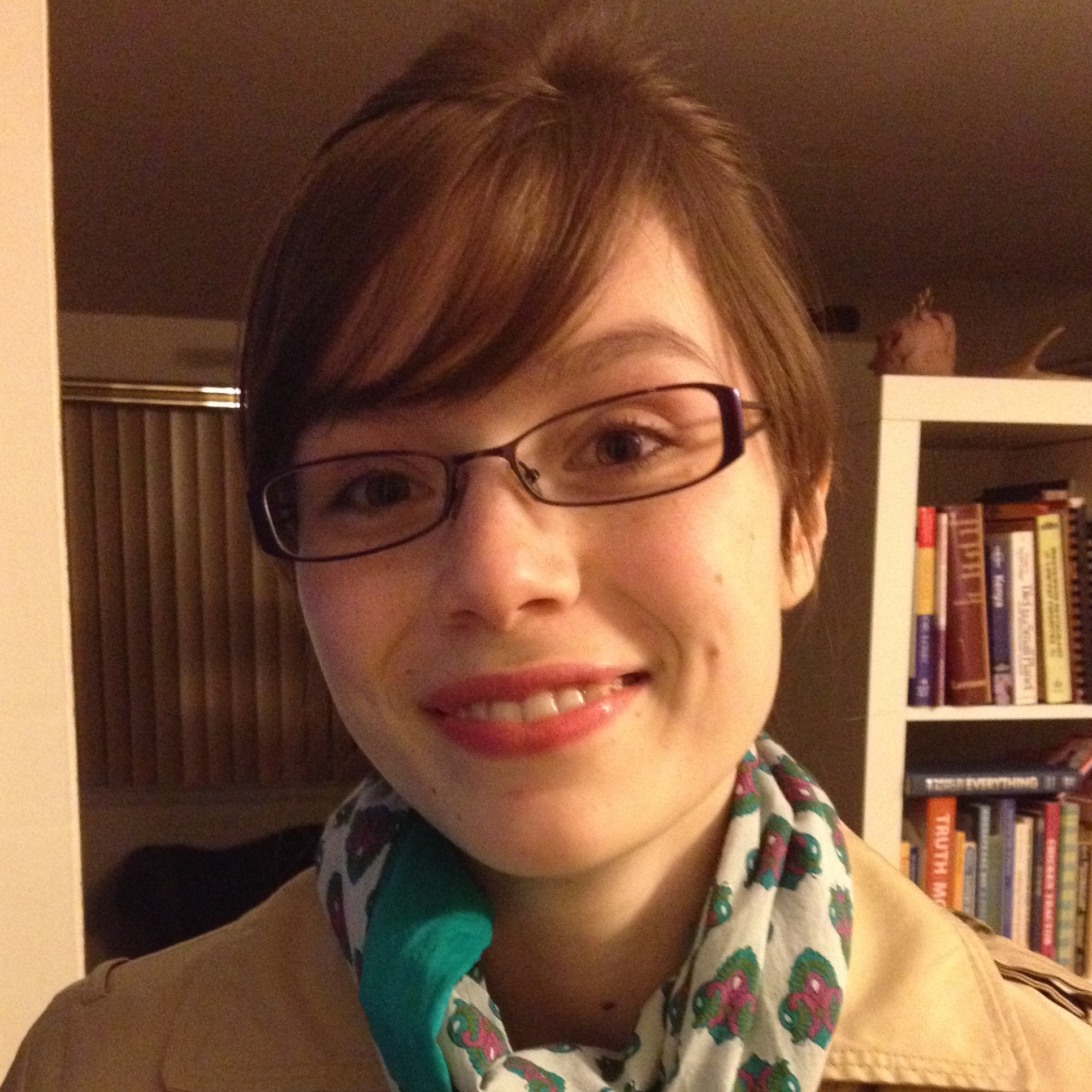
My name is Anastasia Newheart and I am a junior at Howard University studying Physics. I am an intern this summer on the DREAM2 project at GSFC working with Michael Collier. For my research, I am analyzing data from the Suprathermal Ion Detector Experiment (SIDE), part of the Apollo Lunar Surface Experiments Package (ALSEP). There were three SIDE instruments placed on the Moon between 1969 and 1971 by the Apollo 12, 14 and 15 astronauts. SIDE measures positive ions in the energy range between about 7 eV and 3 keV, and in one mode of operation, SIDE attracts thermal ions using a negative voltage on a grid on the top of the instrument to compensate for the positive potential of the lunar surface. I am examining the particle data from the SIDE instrument and comparing to ion cyclotron wave activity using magnetometer data from Peter Chi. I am examining whether a correlation exists between high wave intensities and elevated count rates observed by SIDE. Some of my favorite parts of this internship are learning new programing skills, and learning more about the solar system and physics in general through hearing about all the different research done at GSFC.

Photo courtesy of NSSDC/GSFC
New DREAM2 Model Gives Glimpse into the Invisible World of Electric Asteroids June 25,2014
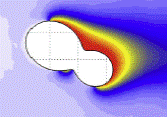
A NASA/GSFC web feature featuring Mike Zimmerman and colleagues recently published model of the solar wind interaction at an asteroid is found at:
The paper itself is at http://www.sciencedirect.com/science/article/pii/S0019103514001158
NASA Completes LADEE Mission with Planned Impact on Moon's Surface April 18, 2014
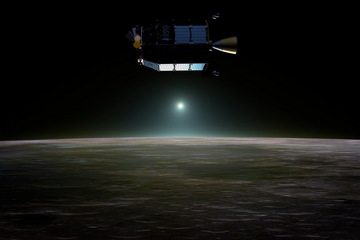
Ground controllers at NASA's Ames Research Center in Moffett Field, Calif., have confirmed that NASA's Lunar Atmosphere and Dust Environment Explorer (LADEE) spacecraft impacted the surface of the moon, as planned, between 9:30 and 10:22 p.m. PDT Thursday, April 17.
NASA Moon probe will bite the lunar dust soon: What is taught us April 17, 2014

Space.com columnist Leonard David describes the great findings from the Lunar Atmosphere and Dust Environment Explorer (LADEE) mission. See:
http://www.space.com/25529-nasa-moon-dust-probe-death-science.html
DREAM2's Pamela Clark featured in Forbes Article on Planetary CubeSats March 3, 2014

A set of DREAM2 investigators are currently examining the use of CubeSats for planetary studies. An article featuring discussions with Pamela can be found at:
LPSC releases its program February 10, 2014
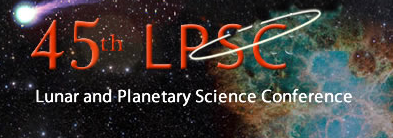
Another exciting program has been put together for the upcoming LPSC meeting from 3/17-21 in The Woodland, TX. DREAM co-Is have numerous presentations, including active involvement in the special LADEE session on Tuesday morning.
See the full program at http://www.hou.usra.edu/meetings/lpsc2014/pdf/program.pdf.
Redistribution of lunar polar water to mid-latitudes January 10, 2014

In December 2013, DREAM scientists published a study in Planetary and Space Science on the possible transport of volatiles from the floor of lunar polar craters to the topside surface at mid-latitudes. Energetic processes like ion sputtering and impact vaporization were shown to eject/release polar water molecules residing within cold trapped regions, possibly with sufficient velocity to allow their redistribution to mid-latitudes. The team then considered the possibility that these polar-ejected molecules contributed to the 3 micron IR absorption featured observed by Chandrayaan-1, Cassini, and EPOXI.
See http://www.sciencedirect.com/science/article/pii/S0032063313001268 for more details.
2013 DREAM News
- NASA Official: William Farrell
- Curator: Evan McGarry
- Privacy Policy & Important Notices

